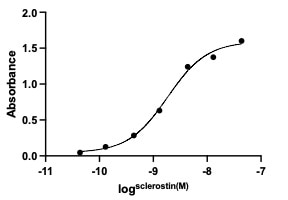Recombinant Mouse LRP-5 Protein Summary
Product Specifications
Met1-Ser1383, with a C-terminal 6-His tag
Analysis
Product Datasheets
Carrier Free
CF stands for Carrier Free (CF). We typically add Bovine Serum Albumin (BSA) as a carrier protein to our recombinant proteins. Adding a carrier protein enhances protein stability, increases shelf-life, and allows the recombinant protein to be stored at a more dilute concentration. The carrier free version does not contain BSA.
In general, we advise purchasing the recombinant protein with BSA for use in cell or tissue culture, or as an ELISA standard. In contrast, the carrier free protein is recommended for applications, in which the presence of BSA could interfere.
7344-LR
| Formulation | Lyophilized from a 0.2 μm filtered solution in PBS with BSA as a carrier protein. |
| Reconstitution | Reconstitute at 100 μg/mL in PBS containing at least 0.1% human or bovine serum albumin. |
| Shipping | The product is shipped at ambient temperature. Upon receipt, store it immediately at the temperature recommended below. |
| Stability & Storage: | Use a manual defrost freezer and avoid repeated freeze-thaw cycles.
|
7344-LR/CF
| Formulation | Lyophilized from a 0.2 μm filtered solution in PBS. |
| Reconstitution | Reconstitute at 100 μg/mL in PBS. |
| Shipping | The product is shipped at ambient temperature. Upon receipt, store it immediately at the temperature recommended below. |
| Stability & Storage: | Use a manual defrost freezer and avoid repeated freeze-thaw cycles.
|
Reconstitution Calculator
Background: LRP-5
The low-density lipoprotein (LDL) receptor-related proteins LRP-5 and LRP-6 (LRP-5/6) constitute a distinct subgroup of the LDL receptor family (1). Both are widely expressed type I transmembrane proteins that function as Wnt co-receptors with Frizzled proteins in the beta -catenin (canonical) signaling pathway. Both also play critical roles in gastrulation and skeletal patterning during development (1-5). The 1614 amino acid (aa) mouse LRP5 contains a 30 aa signal sequence, a 1353 aa extracellular domain (ECD) with four beta -propeller structures, a 23 aa transmembrane domain and a 208 aa cytoplasmic domain (6). The beta -propellers are formed of five LDLR class B domains each, separated by EGF-like motifs, and followed by three cysteine-rich LDLR class A domains (6, 7). The ECD of mouse LRP-5 shares 95%, 99% and 71% aa sequence identity with the ECD of human LRP-5, rat LRP-5, and mouse LRP-6, respectively. LRP-5/6 associates with Wnt/Frizzled complexes, triggering phosphorylation of its intracellular PPPS motifs, binding of Axin, and propagation of beta -catenin signals (1, 7, 8). The LRP-5 ECD can also interact directly with inhibitors, such as Dickkopf (Dkk), Sclerostin, and USAG1/Wise, and the non-Wnt, activating complex of Norrin with Frizzled-4 (2, 7, 9-12). Formation of a ternary complex of LRP-5, Dkk-1, and Kremen triggers the internalization of the complex (1, 2). LRP-5/6 share many, but not all interactions (1, 2). However, deletion of LRP‑6 has a larger effect on embryonic developmental processes, while deletion and polymorphisms of LRP-5 mainly affect bone density (1, 4, 5, 9, 10). In humans, or mouse models, autosomal recessive osteoporosis-pseudoglioma syndrome and hereditary high bone mass (HBM) are caused by loss- and gain-of-function mutations LRP-5, respectively (4, 9, 10, 13). In mice, Wnt/LRP-5 may inhibit duodenal synthesis of the bone antagonist, serotonin, indirectly enhancing bone formation (14). Accordingly, serum serotonin is decreased in human HBM compared to controls (13).
- MacDonald, B.T. et al. (2011) PLoS ONE 6:e23537.
- Kikuchi, A. et al. (2007) Cell. Signal. 19:659.
- Kelly, O.G. et al. (2004) Development 131:2803.
- Joeng, K.S. et al. (2011) Dev. Biol. 359:222.
- Holmen, S.L. et al. (2004) J. Bone Miner. Res. 19:2033.
- Hey, P.J. et al. (1998) Gene 216:103.
- Williams, B.O. and K.L. Insogna (2009) J. Bone Miner. Res. 24:171.
- Tamai, K. et al. (2004) Mol. Cell 13:149.
- Cui, Y. et al. (2011) Nat. Med. 17:684.
- Gong, Y. et al. (2001) Cell 107:513.
- Li, X. et al. (2005) J. Biol. Chem. 280:19883.
- Semenov, M. et al. (2005) J. Biol. Chem. 280:26770.
- Frost, M. et al. (2011) J. Bone Miner. Res. 26:1721.
- Yadav, V.K. et al. (2008) Cell 135:825.
Citations for Recombinant Mouse LRP-5 Protein
R&D Systems personnel manually curate a database that contains references using R&D Systems products. The data collected includes not only links to publications in PubMed, but also provides information about sample types, species, and experimental conditions.
3
Citations: Showing 1 - 3
Filter your results:
Filter by:
-
Human cell surface-AAV interactomes identify LRP6 as blood-brain barrier transcytosis receptor and immune cytokine IL3 as AAV9 binder
Authors: Shay, TF;Jang, S;Brittain, TJ;Chen, X;Walker, B;Tebbutt, C;Fan, Y;Wolfe, DA;Arokiaraj, CM;Sullivan, EE;Ding, X;Wang, TY;Lei, Y;Chuapoco, MR;Chou, TF;Gradinaru, V;
Nature communications
Species: N/A
Sample Types: Recombinant Protein
Applications: Surface Plasmon Resonance (SPR) -
Senescent cells perturb intestinal stem cell differentiation through Ptk7 induced noncanonical Wnt and YAP signaling
Authors: J Yun, S Hansen, O Morris, DT Madden, CP Libeu, AJ Kumar, C Wehrfritz, AH Nile, Y Zhang, L Zhou, Y Liang, Z Modrusan, MB Chen, CC Overall, D Garfield, J Campisi, B Schilling, RN Hannoush, H Jasper
Nature Communications, 2023-01-11;14(1):156.
Species: Mouse
Sample Types: Recombinant Protein
Applications: Surface Plasmon Resonance -
A Norrin/Wnt surrogate antibody stimulates endothelial cell barrier function and rescues retinopathy
Authors: R Chidiac, M Abedin, G Macleod, A Yang, PE Thibeault, LL Blazer, JJ Adams, L Zhang, H Roehrich, HN Jo, S Seshagiri, SS Sidhu, HJ Junge, S Angers
Embo Molecular Medicine, 2021-06-09;0(0):e13977.
Species: Mouse
Sample Types: Recombinant Protein
Applications: Bioassay, ELISA Capture
FAQs
No product specific FAQs exist for this product, however you may
View all Proteins and Enzyme FAQsReviews for Recombinant Mouse LRP-5 Protein
Average Rating: 4 (Based on 2 Reviews)
Have you used Recombinant Mouse LRP-5 Protein?
Submit a review and receive an Amazon gift card.
$25/€18/£15/$25CAN/¥75 Yuan/¥2500 Yen for a review with an image
$10/€7/£6/$10 CAD/¥70 Yuan/¥1110 Yen for a review without an image
Filter by:





